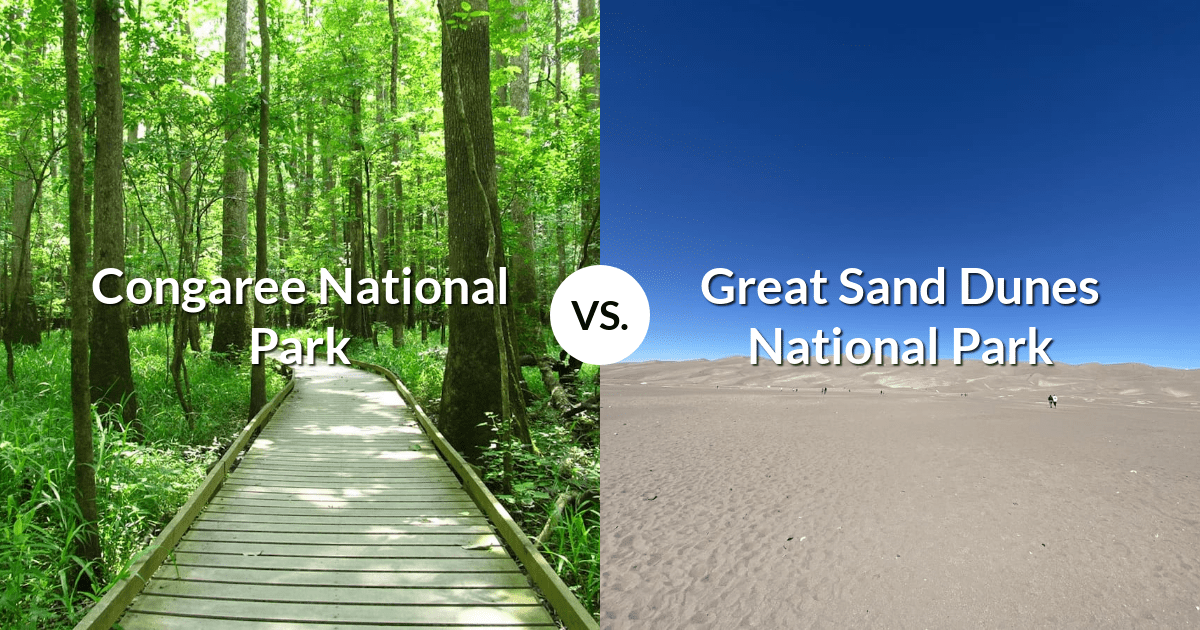Congaree National Park and Great Sand Dunes National Park & Preserve are two of the most unique and diverse national parks in the United States. While Congaree boasts towering trees and a lush, swampy landscape, Great Sand Dunes offers a barren desert environment with towering sand dunes that will take your breath away. Both parks offer a seemingly endless array of outdoor recreational activities, from camping, hiking, and kayaking to sand sledding and stargazing. Whether you’re an adrenaline junkie seeking adventure or a nature lover looking to escape the hustle and bustle of everyday life, these two parks have got you covered. So buckle up, grab your hiking boots and let’s dive into the wild, untamed landscapes of Congaree National Park and Great Sand Dunes National Park & Preserve!
Hiking Trails in Congaree National Park and Great Sand Dunes National Park & Preserve
Congaree National Park in South Carolina is known for its lush forest and scenic boardwalk trails, including the 2.4-mile Boardwalk Loop and the 2.6-mile Weston Lake Loop. These trails are relatively flat and easy to hike, perfect for those who want to enjoy the park’s old-growth bottomland hardwood forest and its diverse wildlife. On the other hand, the 7.4-mile Kingsnake Trail is a strenuous hike that takes you through the park’s backcountry, offering a challenging and rewarding experience for more experienced hikers.
Great Sand Dunes National Park & Preserve in Colorado is famous for its towering sand dunes, which can be explored via several hiking trails. The 1-mile Dunes Loop is an easy hike that provides stunning views of the dunes and the surrounding mountains. For more advanced hikers, the 9.5-mile High Dune Hike offers a strenuous climb to the top of the tallest dune, providing breathtaking panoramic views of the park. The 4.4-mile Medano Pass Primitive Road is also a challenging hike, taking you through the park’s remote backcountry and offering a unique perspective of the sand dunes.
Most Popular Hiking Trails in Congaree National Park
| Name | Length | Elevation | Type | Difficulty | Visitor Ratings |
|---|---|---|---|---|---|
| Boardwalk Loop Trail | 3862.416 | 3.9624 | Easy | loop | 4 |
| Weston Lake Loop Trail | 7402.964 | 4.8768 | Easy | loop | 4 |
| Oakridge Trail | 10138.842 | 5.7912 | Easy | loop | 4 |
| Congaree River Trail | 15932.466 | 15.8496 | Easy | loop | 4 |
| Kingsnake Trail | 11909.116 | 6.7056 | Easy | out and back | 3.5 |
| Congaree Bluff Trail | 3379.614 | 5.7912 | Easy | loop | 3.5 |
| Congaree River Blue Trail | 75317.112 | 1.8288 | Moderate | point to point | 5 |
Most Popular Hiking Trails in Great Sand Dunes National Park & Preserve
| Name | Length | Elevation | Type | Difficulty | Visitor Ratings |
|---|---|---|---|---|---|
| High Dune Trail | 4828.02 | 191.7192 | Hard | out and back | 5 |
| Mosca Pass Trail | 10299.776 | 444.7032 | Moderate | out and back | 4.5 |
| Dunes Trail from Pinyon Flats | 7242.03 | 290.7792 | Hard | loop | 4.5 |
| Sand Dunes Loop Trail | 8046.7 | 225.8568 | Moderate | loop | 4.5 |
| Upper Sand Creek Lake Trail | 11909.116 | 598.932 | Very Hard | out and back | 4.5 |
| Medano Lake Trail | 12713.786 | 697.992 | Moderate | out and back | 4 |
| Montville Nature Trail | 804.67 | 26.8224 | Easy | loop | 4 |
| Dunes Overlook Sand Ramp Trail | 2414.01 | 80.772 | Moderate | out and back | 3.5 |
| Little Medano Creek Trail to Medano Lake | 40394.434 | 1079.9064 | Moderate | out and back | 4 |
| Wellington Ditch Trail | 2896.812 | 47.8536 | Easy | out and back | 4 |
Wildlife in Congaree National Park and Great Sand Dunes National Park & Preserve
Congaree National Park in South Carolina is home to a diverse array of wildlife, including white-tailed deer, river otters, bobcats, and over 200 species of birds such as woodpeckers, owls, and warblers. The park is also home to many threatened and endangered species, such as the Carolina heeler and the ivory-billed woodpecker. Additionally, Congaree is known for its diverse plant life, including champion trees, wildflowers, and carnivorous plants.
In contrast, Great Sand Dunes National Park & Preserve in Colorado is a unique habitat for animals adapted to high altitude desert environments, including pronghorns, black-tailed prairie dogs, and kit foxes. Visitors may also spot a variety of bird species such as the mountain plover, McCown’s longspur, and the northern harrier. The park’s sand dunes support a variety of unique plant species, including the Sand Dune Evening Primrose and the Sand Dune Sunflower.
Below are lists of the most commonly spotted wildlife at Congaree National Park and Great Sand Dunes National Park & Preserve. However, you can see a full list of wildlife at each national park here.
Birds
| Congaree National Park | Great Sand Dunes National Park & Preserve |
|---|---|
| Peregrine Falcon | Peregrine Falcon |
| Northern Harrier | Northern Harrier |
| Sharp-Shinned Hawk | Sharp-Shinned Hawk |
| Osprey | Osprey |
| Tree Swallow | Tree Swallow |
| Mallard | Mallard |
| Canada Goose | Canada Goose |
| Lincoln’s Sparrow | Lincoln’s Sparrow |
| Ruby-Crowned Kinglet | Ruby-Crowned Kinglet |
| American Robin | American Robin |
| Great Horned Owl | Great Horned Owl |
| Red-Tailed Hawk | Red-Tailed Hawk |
| Northern Flicker | Northern Flicker |
| Merlin | Merlin |
| Barn Swallow | Barn Swallow |
| Savannah Sparrow | Savannah Sparrow |
| Great Blue Heron | Great Blue Heron |
| Hermit Thrush | Hermit Thrush |
| American Kestrel | American Kestrel |
| Bald Eagle | Bald Eagle |
| Song Sparrow | Song Sparrow |
| European Starling | European Starling |
| American Wigeon | Northern Pintail |
| Green-Winged Teal | American Wigeon |
| American Pipit | Green-Winged Teal |
Mammals
| Congaree National Park | Great Sand Dunes National Park & Preserve |
|---|---|
| Coyote | Coyote |
| American Beaver | American Beaver |
| Muskrat | Muskrat |
| Big Brown Bat | Big Brown Bat |
| Bobcat | Bobcat |
| Striped Skunk | Striped Skunk |
| Raccoon | Little Brown Bat |
| Black Bear | Deer Mouse |
| Red Fox | Raccoon |
| Mink | Black Bear |
| Common Gray Fox | Porcupine |
| North American River Otter | Silver-Haired Bat |
| White-Tailed Deer | Hoary Bat |
| Virginia Opossum | Red Fox |
| Eastern Red Bat | Long-Tailed Weasel |
| White-Footed Mouse | Mule Deer |
| Eastern Cottontail | Gray Fox |
| Eastern Fox Squirrel | Long-Legged Myotis |
| Eastern Gray Squirrel | Long-Eared Bat |
| Feral Hog | Badger |
| Northern Short-Tailed Shrew | Ermine |
| Least Shrew | Snowshoe Hare |
| Masked Shrew | |
| Water Shrew | |
| Brazilian Free-Tailed Bat |
Reptiles
| Congaree National Park | Great Sand Dunes National Park & Preserve |
|---|---|
| Racer | Bull Snake |
| Ringneck Snake | Western Terrestrial Garter Snake |
| Common Garter Snake | Western Prairie Rattlesnake |
| Common Kingsnake | Greater Short-Horned Lizards |
| Milksnake | |
| Eastern Fence Lizard |
Insects
| Congaree National Park | Great Sand Dunes National Park & Preserve |
|---|---|
| Alfalfa Sulphur | |
| Monarch | |
| American Painted Lady | |
| Red Admiral | |
| Mourning Cloak | |
| Cabbage Butterfly | |
| Checkered Skipper | |
| Variegated Fritillary | |
| Buckeye | |
| Commom Wood Nymph | |
| Gray Hairstreak |
Fish
| Congaree National Park | Great Sand Dunes National Park & Preserve |
|---|---|
| Largemouth Bass | Brook Trout |
| Green Sunfish | German Brown Trout |
| Bluegill | Cutthroat Trout |
| Golden Shiner | |
| European Carp | |
| Yellow Bullhead | |
| Graceful Catfish | |
| Black Crappie | |
| Mosquitofish | |
| Brown Bullhead |
Amphibians
| Congaree National Park | Great Sand Dunes National Park & Preserve |
|---|---|
| Northern Leopard Frog | |
| Tiger Salamander | |
| Woodhouse’s Toad | |
| Plains Spadefoot |
Beautiful Landscapes in Congaree National Park and Great Sand Dunes National Park & Preserve
Congaree National Park features the largest intact expanse of old-growth bottomland hardwood forest in North America, with towering loblolly pines and oak trees. The park also has a 2.4-mile boardwalk that meanders through the swamp, providing opportunities for wildlife viewing, bird watching, and hiking.
Great Sand Dunes National Park & Preserve is home to the tallest sand dunes in North America, reaching up to 750 feet. The park also has a diverse landscape, including alpine lakes, forests, and wetlands, making it a popular spot for hiking, sand sledding, and camping. The park also has a scenic drive that offers stunning views of the dunes and the surrounding mountains.
Things To-Do and Activities in Congaree National Park and Great Sand Dunes National Park & Preserve
Congaree National Park is known for its unique old-growth bottomland hardwood forest, which visitors can explore through various trails, kayaking, and canoeing. On the other hand, Great Sand Dunes National Park & Preserve is famous for its towering sand dunes, which visitors can hike and even sled or sandboard down. The park also has opportunities for backpacking, horseback riding, and fishing in the nearby Medano Creek. Both parks offer scenic drives, ranger-led programs, and camping for those wanting to spend more time in nature.
In summary, Congaree National Park is a destination for those interested in exploring a unique forest habitat, while Great Sand Dunes National Park & Preserve draws visitors to its towering sand dunes and opportunities for outdoor recreation.
Best Time to Visit Congaree National Park and Great Sand Dunes National Park & Preserve
Congaree National Park, located in South Carolina, has hot and humid summers with temperatures ranging from the mid 80s to low 90s, while winters are mild with temperatures ranging from the mid 40s to low 50s. The park experiences heavy rainfall throughout the year, with the wettest months being from May to September.
On the other hand, Great Sand Dunes National Park & Preserve, located in Colorado, has warm summers with temperatures ranging from the mid 70s to low 80s and cold winters with temperatures ranging from the mid 20s to low 30s. The park receives limited precipitation, with most of it falling from April to June.
The best time to visit Congaree National Park is in the winter or spring, when the weather is mild and the park is less crowded, while the best time to visit Great Sand Dunes National Park & Preserve is in the summer, when temperatures are warm, and the park’s sand dunes are accessible for recreational activities.
Family Friendliness of Congaree National Park and Great Sand Dunes National Park & Preserve
Congaree and Great Sand Dunes are both family-friendly parks with unique experiences to offer. Congaree has lush forest trails for hiking and canoeing, while Great Sand Dunes provides sand dune activities such as sledding and sandboarding. Congaree is more of a nature-based park with opportunities for wildlife viewing, while Great Sand Dunes is more focused on outdoor recreation. Ultimately, the better choice depends on personal preferences and the age of the children, but both parks are great options for families looking for a fun outdoor adventure.

